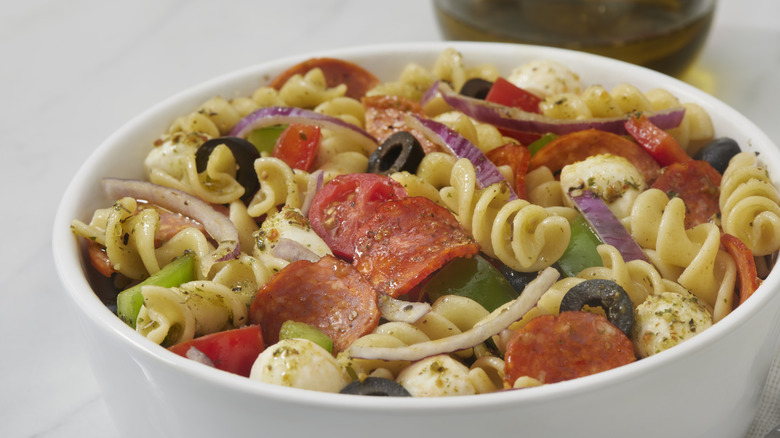Is Turkey Pepperoni Healthier Than Regular Pepperoni? Yes, But Don't Get Too Excited
You don't have to be a pizza fiend to love pepperoni. Whether you enjoy it on a cracker with cheese, diced up in a pasta dish, or right out of the bag, pepperoni is delicious. Its tastiness probably has a lot to do with it being chockful of fat and sodium — the ingredients our tongue loves — but our body hates due to just how unhealthy they can be.
Because the fat and sodium content in pepperoni isn't doing anyone any favors — just 14 slices contain 13 grams of fat and a whopping 443 milligrams of sodium — you might want a healthier option. Turkey pepperoni, perhaps? After all, turkey is low in calories and fat, high in protein, and rich in essential nutrients, and the American Heart Association gives it its stamp of approval — as long as you're not deep frying it or anything similar. Taking that into consideration, it would seem turkey pepperoni is far healthier than pork pepperoni. However, that's not exactly the case.
"Food is about how you eat it and not always what you eat, but when you compare these two foods, turkey pepperoni beats regular pepperoni in a few categories," Alexis Law, a Registered Dietitian at Top Nutrition Coaching, told Health Digest while pointing out the aforementioned health benefits of turkey. "[Turkey pepperoni] even has very, very slightly more iron and potassium, which regular pepperoni does not have, [but] regular pepperoni has less salt and cholesterol, only by a small amount." In other words, seeing the word "turkey" in front of the word "pepperoni" only means so much and definitely not as much as most of us would like.
Turkey pepperoni versus regular pepperoni
Calories and fat are the big differences between these two different types of pepperoni. According to Nutritionix, 14 slices of pepperoni and 17 slices of turkey pepperoni equal 141 calories and 70 calories, respectively. So if you're someone who's counting calories, for whatever reason, then of course, turkey is going to be the better and healthier option. There's also a big difference in the fat content per serving: 13 grams of total fat, with 5 of those grams being saturated fats, for pepperoni, and four grams of total fat, 1.5 grams of which is saturated, for the turkey pepperoni.
But as Law also mentioned, it's the sodium and cholesterol that's worth noting. While regular pepperoni has 27 milligrams of cholesterol and 443 milligrams of sodium, the turkey-based pepperoni has 35 milligrams of cholesterol and 570 milligrams of sodium. Those numbers may look like a big difference, but because we're dealing with milligrams, it really isn't enough to matter all that much.
But in other pro-turkey pepperoni news, it has almost twice the amount of protein. According to the Mayo Clinic, 10% to 35% of your calorie intake should be protein, so protein content in your food matters. Ultimately, based on your health goals, turkey may be a better fit for you, but that doesn't mean it's necessarily healthier, especially if you're concerned about sodium and cholesterol because that stuff can add up quickly.
How to make pepperoni healthy
If you love pepperoni — either pork- or turkey-based — and you have no intention of giving it up, then what you can do is consume it in a healthier way. For starters, that means eating it in moderation, as opposed to going to town on a whole bag every night after work, no matter how yummy it is. Eating processed meat daily isn't just bad for your body, but according to a 2021 study published in The American Journal of Clinical Nutrition, consuming as little as 25 grams of processed meat every day can increase one's chances of developing dementia by 44%. That 25 grams is less than one serving size of both pepperoni and turkey pepperoni.
"If you wanted to eat pepperoni in a way that supports a generally balanced diet, I would pair it with a snack plate where you also have some veggie snacks like baby carrots and cucumbers and even some fruit like berries or even some whole wheat crackers," said Law. "It can make a nice protein addition to help you feel full with a snack."
You can also incorporate it into meals. For example, pepperoni can give a veggie omelet a bit of a kick, substitute for the ham in chicken cordon bleu, or spice up a pasta and vegetable salad. Pepperoni can be consumed in a healthy way, if you're willing to combine it with other foods that bring a level of nutrition to the equation.



